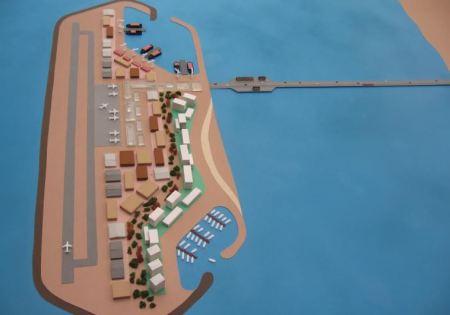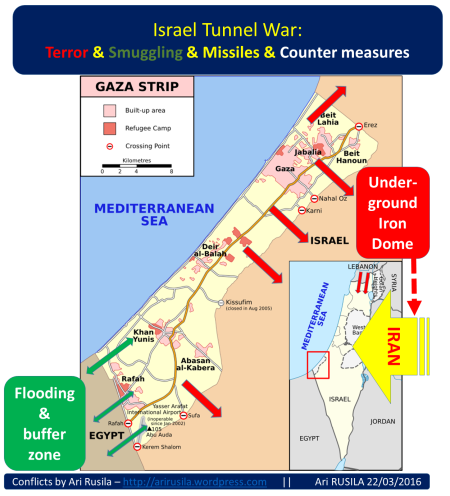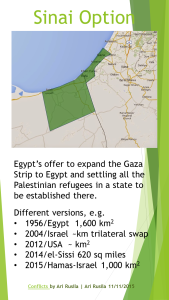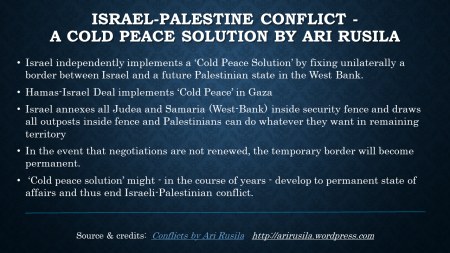A proposal to provide the Gaza Strip with an outlet to the rest of the world through a man-made island could soon become a reality, Israel’s Intelligence and Transportation Minister Israel Katz said Monday [20th June 2016], according the Jerusalem Post. Although the idea of building this artificial island has been floating around for years, real headway has only been made in the recent months, according to Katz, who estimates the project will cost some $5 billion.
The project would include a 5 km. bridge from the Gaza Strip through Israeli waters and into the planned 8 sq. km. chunk of land, which likely would have a marine port and, eventually, an airport, in addition to a hotel and small port for yachts.

Gaza island model as presented on June 20, 2016. (photo credit:COURTESY/THE ISRAEL PROJECT)
Hamas has said that among its conditions for a long-term truce with Israel are the reopening of the Strip’s Yasser Arafat Airport and construction of a new seaport. Such an option on existing Gaza land, Katz said, would put Israel’s security at risk and allow Hamas to misuse funds allocated for its construction. According to Katz, the process is still being deliberated by officials who are mainly trying to decide how exactly Israel would be involved in maintaining security at a port that would be internationally funded and secured. The minister said the project would not be built or funded by Israel in any way. Rather, he said, the initiative is more of a statement of support were this plan come to fruition and Israel would allow international entities to enter Israeli waters in order to carry out construction.
Katz acknowledged that the island would not necessarily put an end to weapon smuggling and rocket firings at Israel, but would help the populace to become less radical as it receives a better standard of living and the possibility of traveling and commerce with the rest of the world without Israeli involvement.
In May, Katz announced an initiative that would transfer Turkish goods to Jordan and onward to the rest of the region through Israel via a train route from the Port of Haifa to Beit She’an, which is a 15-minute drive from the Sheikh Hussein Border Crossing into Jordan. Source: Jerusalem Post
New Gaza wall
Up within the Israeli defense establishment, many believe that the time has come for Israel to set up a civilian seaport for the Gaza Strip. According to their view, if Gaza is going to stop exploding into conflict every two years, its 1.8 million residents need to have better hope for the future.
While the new port is part of the defense establishment’s concept of “restraining factors” that Israel can put into place, there is also military counterterrorism measures, to push back the next war for as long as possible.
One such new planed investment is a New Gaza wall. According The Jerusalem Post Israel’s defense establishment plans to build a concrete wall that goes tens of yards underground as well as above ground along the Gaza Strip border. Implementation of the plan will cost an estimated $568 million. The wall is intended to block off any terror tunnels, and will be constructed solely on Israeli soil.
Israel’s plan to block off Gaza above and below ground with security wall has been met with an uproar from Gaza Arabs, who are demanding that the UN intervene and halt construction plans. Gazans have loudly protested the wall, at least partially on environmental grounds.

Egypt’s Gaza barrier
Sea-based smuggling rising
As Israel sends some 900 trucks per day into Gaza, carrying all manner of goods, medical equipment, food, fuel and construction material, it is hardly enough to keep the Gaza Strip’s economy functional. To get more goods, luxery items and weapons and weapon materials Hamas has used its smuggling tunnels. The original tunnels on Egypt-Gaza border were used to smuggle arms and commercial goods from Egypt to Gaza. Hamas substantially expanded this infrastructure after 2007 and Israel’s imposition of a sc, blockade. At the time, it is estimated that there were as many as 2,500 such tunnels running between Gaza and Egypt in the area of Rafah. There are estimates that as much as $3 billion in goods were moved annually from Sinai into Gaza. However since former Egyptian President Mohammed Morsi was ousted in June 2013, the Egyptian military has eliminated most of the smuggling tunnels beneath the border in the southern Gaza Strip and expanded the buffer zone. Egypt has demolished tunnels e.g. by exploding them, Egyptian army also fires tear gas or throws wastewater inside the tunnels to kill diggers. (More in Gaza Blockade – It’s Egypt not Israel! and Gaza’s Tunnel War Continues On All Fronts )

Earlier in May 2016 security forces announced the arrest of a suspected Gazan weapons smuggler who disguised himself as a fisherman. In a joint navy, Shin Bet and Israel Police operation, security forces said that during questioning, “it emerged that for a lengthy period, he was involved in sea-based smuggling of weapons and other items, for Hamas and other terrorist elements in the Gaza Strip.”
The suspect allegedly smuggled ammunition and liquid fiberglass used to manufacture rockets. Details on Hamas’s operational plans in the Mediterranean Sea also arose in the investigation, the domestic intelligence agency said, including its use of fishing boats to disguise its activities. (Source: Jerusalem Post )
Conflicting views related to Israeli security
Would the creation of a seaport enable Hamas to upgrade its weapons smuggling program? According to former navy chief V.-Adm. (res.) Eliezer Marom, the answer is an unequivocal yes: “In general, my view is absolutely opposed to a Gaza port. It is a certain recipe for Iranian military boats arriving in Gaza. We do not want that to happen.” Hamas, he added, has “very high motivation to smuggle via the sea. It uses fishing boats to smuggle between Sinai and the Gaza Strip,” and the need for sea arms-trafficking routes has grown since Egypt began blocking smuggling tunnels linking Sinai to Gaza. (Source: Jerusalem Post )
But others took a different view. Brig.-Gen. (res.) Shlomo Brom, head of the Program on Israeli-Palestinian Relations at the Institute for National Security Studies in Tel Aviv, told The Jerusalem Post that a Gazan port would assist, not harm, Israeli security. Brom, who in the IDF headed the Strategic Planning Division in the Planning Branch of the General Staff, said, “I am among those who support the idea. Without a port, the Gaza Strip will continue to be a pressure cooker housing two million people which explodes every once in a while. There are a few good ideas that enable the operation of a port, with good security supervision, that will prevent it from being exploited to smuggle weapons.”
Such ideas include making every vessel en route to Gaza dock in Cyprus first, where its cargo will undergo a security check. (Source: Jerusalem Post )
Wider context
Brig.-Gen. (res.) Moni Chorev, a researcher at the Begin-Sadat Center for Strategic Studies at Bar-Ilan University, said the idea of a seaport for Gaza could not divorced from the wider strategic picture. Chorev, a former IDF division commander and former head of the officer training school, told the Post that one must place the Gaza port question in a far wider context. “Since Hamas rose to power in 2007, the Gazan economy has been kept down. Is there room to change Gaza’s economic situation? This question is not only about Gaza, however. If you look at the Palestinians as a whole, one must weigh up how creating economic growth in Gaza will affect [President] Mahmoud Abbas, the PA, and its ability to rule,” he said. That question, in turn, is tied into how Egypt, Saudi Arabia, Jordan and perhaps Turkey will interact with Israel and the Palestinians in the coming years, Chorev argued. “If you want to enlist the Egyptians, one must realize that they view Hamas as a sort of extension of their biggest enemy, the Muslim Brothers,” he said. Thus, a port would have an impact on the wider Palestinian, Arab and regional arena.
If Gazans are provided with new hope and an economic horizon, Hamas will be significantly less willing to risk the wrath of the people it controls by launching reckless and costly military attacks on Israel, he said. (Source: Jerusalem Post )
According reports the deal would include the lifting of the blockade on Gaza. According to the reports, Gaza will be allowed to import merchandise through a “floating port” located 3 kilometers (1.8 miles) off the coast. An intermediary port will be established in Cyprus, where all Gaza-bound merchandise will be scrutinized by NATO representatives.
Earlier in August 2015 it was reported in the Times of Israel, that Hamas and Israel have essentially agreed on a long-term cease-fire. Hamas is about to sign a “comprehensive” agreement with Israel for the lifting of an eight-year blockade placed on the Gaza Strip in return for a long-term ceasefire The gist of the deal is that Israel will end the blockade and allow thousands of Palestinian day laborers to enter Israel. Gaza will import items through a Cyprus port overseen by NATO representatives (until a floating offshore port can be developed) and cease all rocket fire and tunneling for eight years. A prisoner swap may be in the works too. Hamas-Israel Deal could pave way for the ‘Cold Peace Solution’. (More in Hamas and Israel on Verge of the Deal )
 On November 2015 Jerusalem Post reported that Palestinian Authority President Mahmoud Abbas was claiming that Israel and Hamas have been conducting direct negotiations to expand the Gaza Strip so that it would include some 1,000 square kilometers of Sinai. At its core, the Egyptian initiative proposes expanding the Gaza Strip to five times its current size and settling all the Palestinian refugees in a state to be established there. Under the initiative, this state will be demilitarized, the Palestinian Authority would be granted autonomy in the Palestinian cities in the West Bank in exchange for relinquishing the Palestinian demand to return to 1967 borders. (More in Sinai Option again )
On November 2015 Jerusalem Post reported that Palestinian Authority President Mahmoud Abbas was claiming that Israel and Hamas have been conducting direct negotiations to expand the Gaza Strip so that it would include some 1,000 square kilometers of Sinai. At its core, the Egyptian initiative proposes expanding the Gaza Strip to five times its current size and settling all the Palestinian refugees in a state to be established there. Under the initiative, this state will be demilitarized, the Palestinian Authority would be granted autonomy in the Palestinian cities in the West Bank in exchange for relinquishing the Palestinian demand to return to 1967 borders. (More in Sinai Option again )
In my opinion annexing part of Sinai to Gaza as might partly solve Arab-Israeli Conflict. In addition Hamas-Israel Deal could pave way for the ‘Cold Peace Solution’ and beyond. With this context the Gaza seaport is from point of view a positive step forward.

Related articles:
Analysis: Resolving The Israeli-Palestinian Conflict
Gaza’s Tunnel War Continues On All Fronts
Hamas and Israel on Verge of the Deal
Gaza State Under Construction, West Bank Remains Bystander

